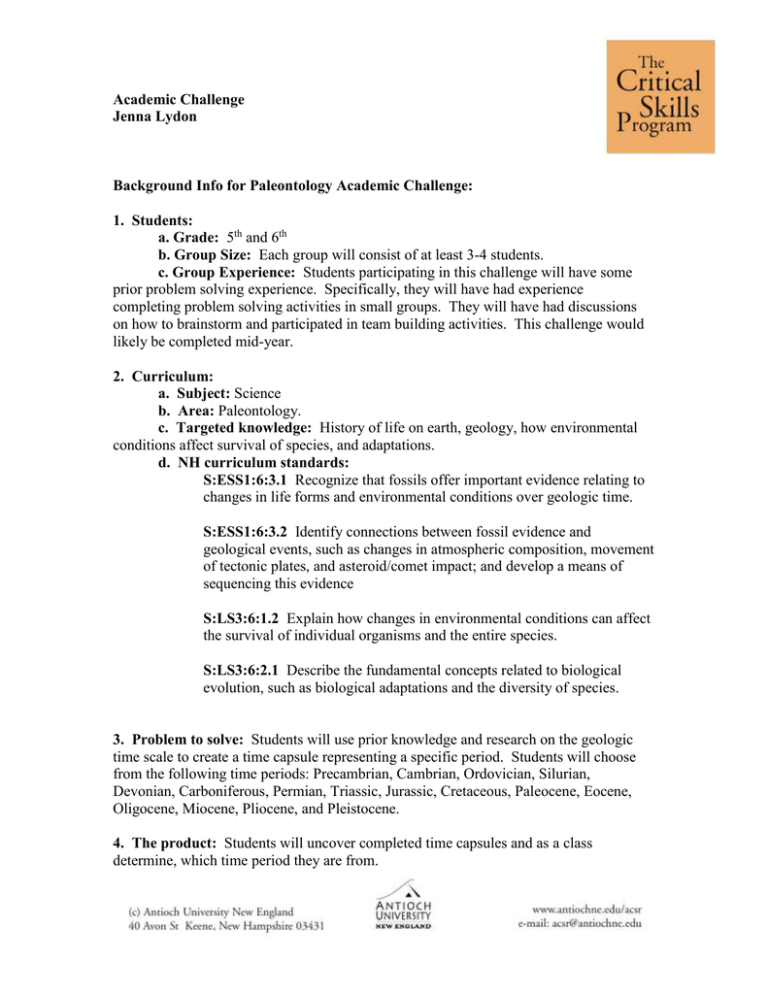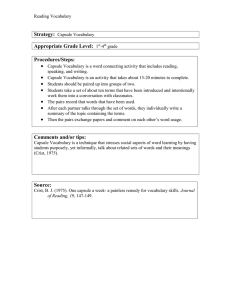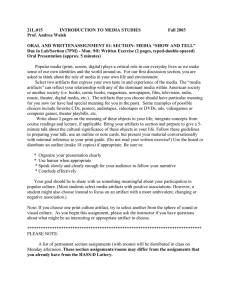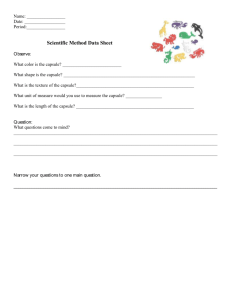Paleontology
advertisement

Academic Challenge Jenna Lydon Background Info for Paleontology Academic Challenge: 1. Students: a. Grade: 5th and 6th b. Group Size: Each group will consist of at least 3-4 students. c. Group Experience: Students participating in this challenge will have some prior problem solving experience. Specifically, they will have had experience completing problem solving activities in small groups. They will have had discussions on how to brainstorm and participated in team building activities. This challenge would likely be completed mid-year. 2. Curriculum: a. Subject: Science b. Area: Paleontology. c. Targeted knowledge: History of life on earth, geology, how environmental conditions affect survival of species, and adaptations. d. NH curriculum standards: S:ESS1:6:3.1 Recognize that fossils offer important evidence relating to changes in life forms and environmental conditions over geologic time. S:ESS1:6:3.2 Identify connections between fossil evidence and geological events, such as changes in atmospheric composition, movement of tectonic plates, and asteroid/comet impact; and develop a means of sequencing this evidence S:LS3:6:1.2 Explain how changes in environmental conditions can affect the survival of individual organisms and the entire species. S:LS3:6:2.1 Describe the fundamental concepts related to biological evolution, such as biological adaptations and the diversity of species. 3. Problem to solve: Students will use prior knowledge and research on the geologic time scale to create a time capsule representing a specific period. Students will choose from the following time periods: Precambrian, Cambrian, Ordovician, Silurian, Devonian, Carboniferous, Permian, Triassic, Jurassic, Cretaceous, Paleocene, Eocene, Oligocene, Miocene, Pliocene, and Pleistocene. 4. The product: Students will uncover completed time capsules and as a class determine, which time period they are from. 5. Establishing quality criteria: Students will help establish the quality criteria for this project. Specifically, I will ask students to consider how they work as team to solve the problem, the quality and creativity of the final product, the accuracy of the time capsule, the overall impac, and their demonstration of knowledge of the time period. I will also model my expectations by showing students an example of a time capsule. I will use a time capsule from the present day Holocene Epoch to represent the quality, creativity, and craftsmanship that I expect from their work. 6. Time line: This project will come at the end of the paleontology unit. Because students will be using their prior knowledge and experiences to complete this challenge, I estimate it will take about one full week. In this time, students will select a period and construct at least four artifacts to go inside the time capsule. On the last day, we will have a celebration and students will uncover the time capsules and determine where they are from. Paleontology Academic Challenge: Introduction: From the very beginning of time, Earth has undergone many drastic changes. These changes in environmental conditions often affect the survival of individual organisms and of entire species. As a result, when studying the history of life on Earth, paleontologists often find organisms with distinguishing adaptations that helped them to survive during their specific geologic time period. Challenge: Your challenge is to create a time capsule that represents the major geologic events of your time period and the adaptations animals and plants had that either helped or hindered their survival in that specific geologic time period. You should design a time capsule that without explanation, will inform your fellow classmates and teachers what time period it is from. Criteria: 1. You must include at least one plant based artifact, one animal based artifact, one climate based artifact, and one geologic event based artifact, beyond that you may include as many other artifacts as you feel are necessary to reflect your time period. 2. Be Creative, but remember all of your creations must fit inside your time capsule. One week from today, as a class we will uncover each of your time capsules. Then, we will take turns predicting which of the time periods we believe each of the time capsules are from. Evaluation: Each time capsule will be assessed based of a list of quality criteria created by you, as well as the following rubric: Time Capsule Scoring Rubric 4 3 2 1 Product Quality The product is exceptionally well designed, neat, and shows care. The product is also thorough, clear and easy to understand. The product is neat, relatively attractive and shows care. The product is clear and easy to understand. The product is not very thorough or very clear but shows some care or thought of quality. The product appears messy and "thrown together" without care or thought of quality. ContentContains all the pieces. 1. Plant artifact 2. Animal artifact 3. Climate artifact 4. Geologic event artifact The artifacts in the time capsule were exceptionally well crafted and showed great creativity. The class was able to guess your time period and understand why the importance of your artifacts. Contains 3 of the 4 pieces. Contains 2 of the 4 pieces. Contains 1 of the 4 pieces. Overall, most of the artifacts included in the time capsule were well crafted and creative. Most members of the class were able to guess your time period and understand why you included the artifacts you chose. You generally demonstrated knowledge and understanding of your time period. Some artifacts included in the time capsule showed some creativity and good craftsmanship. Some members of the class were ale to guess your time period. Some of the artifacts included needed further explanation. In general, knowledge of your time period was demonstrated, but could have been more thorough. The artifacts included in the time capsule showed little creativity and little effort in craftsmanship. The class was unable to guess your time period based on the artifacts in your time capsule. Most of your artifacts needed further explanation. In general, it was not clear that you understood your time period. Most group members were part of the decision and most contributed to the completion of the final product. Some group members were part of the decision and some contributed to the completion of the final product. Group members did not work together in the decision making process or in the completion of the final product. Creativity Impact Knowledge You demonstrated a deep and thorough knowledge and understanding of your time period. Communication All group members and were part of the Collaboration decision and each contributed to the completion of the final product.



